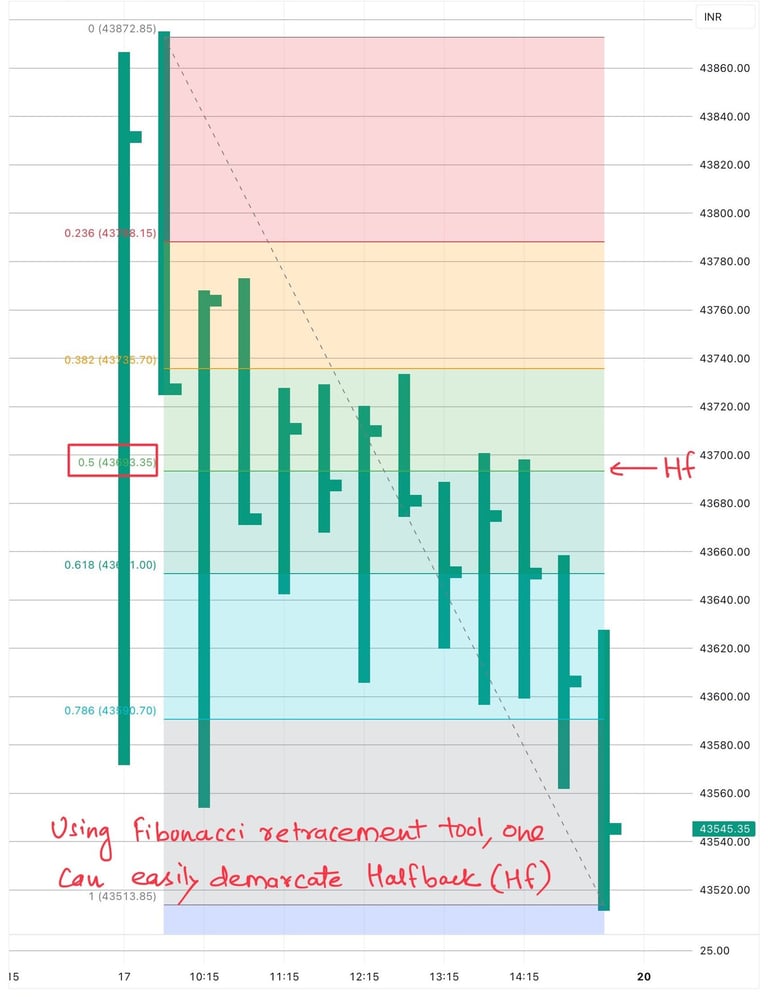Reference points & its behavioral aspects
Each Support & Resistance level has a story to tell, one must be able to listen to it!
11/22/20233 min read


Reference point: This is nothing but the sophisticated jargon for Support & Resistance.
Here is the list of some important reference points:
1. Open
2. Previous day’s close or settle (PDC)
3. Previous day’ High & Low (PDH & PDL respectively)
4. Previous day’s Rally High (RH) & Pullback Low (PBL)
5. Dynamic references: Hf & High-volume node (HVN)
6. Market profile-based references: POC, VAH, VAL, Hf, single print excess, extremes & gaps
7. Balance area (BA) margins & long term excess
8. Weekly or Monthly bar's- High & low
9. Psychological references i.e., round figures
10. Moving averages, Trendlines etc.
Let me add a note on Hf here for its dynamicity.
Halfback (Hf): -
As the day’s range develops over time, Hf may keep varying. At EOD, the Hf for days profile may act as a reference point for next trading session. Even, every 30 min Period too has its own Hf, but it may act as useful element only for the given day. Unlike Day's Hf it has no significance for next trading session.
Behavioral aspects of reference points:
Unlike conventional price action trading, which uses support & resistance levels as a buy or sell signals; JD has a very different way to look at reference points, and that’s behavioral one. It means, we can differentiate between presence of weak or strong money with the help of market activity around those reference points. It is crucial to note that, strongest of the money i.e., LT money don’t care about majority of the reference points we use; for them, even such references ‘to act’ or ‘to make a decision’ do not exist; partly due to their fundamentalist nature and partly due to the fact that they are market makers. Huge amount of pension funds, mutual funds etc. do have huge sums of investor’s money & they have to invest almost each moment which makes reference points inconsequential for them! Still, it is to be noted that 100/200 DMA are crucial reference points for them. So, the question arises, who uses the reference points?
It is the weak money- DTP & ST money both, who base their trade decisions on some kind of anchor i.e., reference points. When a day’s market activity occurs frequently at exactly or very close to some reference point, be assured that it is the weak money dominating the day’s market activity. When you know your competition- whether weak or strong money, then your trading strategy & market expectations will vary accordingly. Also, it is weak money who are heavily leveraged & their business model is to try to be in any kind of short-term price momentum to make profits. As said earlier, they are called ‘weak’ money, because they don’t stick to their trades- they are almost ready to enter any opportunity & exit whenever they are either satisfied with targets or are forced to exit.
Reference points and the TFs responsible for the market activity around them provides significance to each of these reference points. Thus, some reference points may be more significant for DTP, while others are for ST or ITM or LT money; and those reference points at which almost every TF get interested, has the highest significance. The complex interplays of various TFs & multiple reference points having varied significance leads to the formation of some kind of patterns, which broadly have been identified as trends & consolidation. JD prefers to use the term called bracket or balance areas for consolidation; since my concepts too have evolved around his terms, I advise you to get used to the newer terms.
Let me add here, there is a reason why JD have said that some readers have called his books too complicated; because his concepts require a lot of unlearning of the acquired bad habits; & this is what makes most of us uncomfortable. Again, to repeat, learning JD’s concepts is a process which demands commitment to lot of unlearning & re-learning!
Let me add a note on destination trade, it is doing a trade with some reference point taken as expected target & then monitor that trade for continuation. This another way to look at reference points underlines its role in monitoring a destination trade; & conviction of market players can be judged based on expected behavior & observing what has happened & what didn’t happen around the successive reference points. Such kind of monitoring skill requires experience, & with practice one starts to realize that what didn’t happen in the market is rather more important than what has happened. It’s a nuance!
